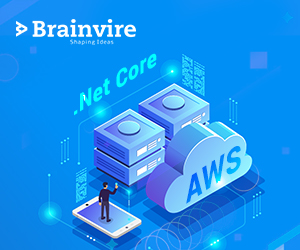
There are several aspects that one must get familiar with AWS SDK for .NET. To begin with, one must know where to start from, how to use it to build .NET Core applications, etc.
A couple of topics in this extract will provide you insights about .NET applications for AWS.
In this article, we have discussed the following about building .NET applications for AWS-
- Learning About AWS SDK
- Using IAM to Secure AWS Requests
- How to Create a User in AWS IAM?
- Develop the Skill to Apply AWS Credentials Locally
- Is There a Need to Register Credentials with the SDK Store?
- AWS SDK Essentials
Learning About AWS SDK
The AWS SDK offers libraries to manage and consume AWS resources and services programmatically. Nugget is a useful source to avail SDK libraries as it offers a couple of packages related to AWS services specifically.
AWS is easily accessible through different tools such as AWS CLI experience or the AWS Console. When you plan to work with AWS .NET Code, the available SDK allows you to use C# to interact and command with different AWS resources.
Using IAM to Secure AWS Requests
To ensure that an authorized and authenticated user accesses the AWS account, you must secure all the requests to AWS. You can also secure resources and services in a similar manner.
It is difficult and daunting to understand all the AWS security complexities and the Identity and Access Management (IAM) service at once. But, we will provide a sufficient foundation that can guide you to get started with the use of AWS for the .NET application development.
To begin with, applications and people are regarded as principals in this service. They are granted permissions within an AWS account. For instance, a principal may be an application operating with AWS services or an actual individual such as a developer.
In this extract, we will concentrate on creating a user. When you create an AWS account for the very first time, you need an email address and password for a root user.
This is your fundamental admin user that offers you access and power to do everything within the AWS account. It is recommended to create one or more users to carry-out day-to-day operations within AWS.
IAM can provide access permissions and therefore you need to create one or multiple users.
For instance, some create a user while developing an application locally and use it with no access permissions. Instead, experts recommend applying a permission approach for only those areas where needed.
This can be implemented through AWS Console which comprises a web-based GUI to handle AWS.
Once you get familiar with AWS, you would prefer a repeatable approach to configure AWS services rather than Console. There are smarter ways to script your commands such as AWS Tool for PowerShell or AWS CLI.
You can define and update AWS services and investigate Cloud Formation with an infrastructure-as-code approach. The successful implementation of Cloud Formation and use of its templates help define the services that can be created and deployed repeatedly and reliably in any environment.
How to Create a User in AWS IAM?
IAM supports the security aspect for your AWS account and is a free service. You can use this service to describe a user with limited access permissions as this can be lucrative for local development and to connect to AWS services.
Once you have logged into AWS, use the search bar to Find Services and simply type IAM.
Click on the service link and you can view the IAM dashboard that provides you an overview of the IAM resources for the existing AWS account.
Choose the Users option on the menu section to view and handle user principles. Click on Add User to create a new user and begin the process. This will lead you to the add user wizard section.
You can also provide a custom name for the user principle, choose the access type during the .NET application development. This will help you provide terminal and pragmatic access.
Yet another option is AWS management Console access where you can select AWS console password to enable secure user login. The next few steps can be skipped if no changes are to be made.
The final step is quite important in case you have chosen programmatic access as it allows you to create Secret Access and Access Key ID.
Develop the Skill to Apply AWS Credentials Locally
Once you have downloaded the credentials, they need to be registered so that AWS SDK and CLI can easily access them. These tools help check several locations for credentials. Hence, you can apply them to your local development machine.
A few locations act as a subset of the AWS management tools.
For CLI and SDK development, define two environment variables that are suitable for the credentials. To implement this, add an AWS Access Key ID environment variable with the same value as in the AWS Console. Or the credentials.csv file.
The next step is to add the environment variable named AWS Secret Key with the value available in the console from the downloaded credentials file.
In case, you plan to use Visual Studio for the development of your .NET application, then you can use AWS Toolkit for Visual Studio. This is quite an upfront approach and supports both VS 2019 and VS 2017.
Add this extension to VS and you have quick access to improved features and templates for AWS based projects. The installation of AWS Toolkit is quite self-explanatory and all the necessary steps are mentioned in the AWS documentation.
Is There a Need to Register Credentials with the SDK Store?
Go to View and click on AWS Explorer in the Visual Studio menu to register some credentials; you can also use AWS Toolkit for it.
With this done, a separate account profile window pops-up where you can create profiles. AWS tools support registration of multiple profiles with diverse logical names and this makes it easy to load the credentials.
In the New Account Profile, the SDK searches for a default name. The storage location offers you two alternatives and the choice depends on where you can use the credentials.
The benefit of using the SDK store is that it is suitable for AWS tools. It is easy to add profiles without the additional hassle of installation and use of AWS Toolkit.
The alternative option is the .NET Encrypted Store and it is supported through .NET SDK and the AWS Toolkit for PowerShell. However, this store has certain limitations which restricts its usage and additional feature potential.
Therefore, a SDK store can be highly beneficial to create users and register credentials.
AWS SDK Essentials
- Development of a simple .NET Core application that is AWS-friendly.
- Create a worker service project via the .NET CLI or from Visual Studio.
- Add the right package with AWS extensions, SDK integration, built-in injection container, libraries, and core features.
- The right code adds a suitable configuration section and accumulates available data along with the region value. You can also install additional AWS SDK libraries for your convenience.
Experienced ASP.NET Core development services provide the best recommendations based on your requirements.
Brainvire’s experts can provide you with a detailed understanding of all these aspects. Contact us Today!
Related Articles
-
Microsoft SharePoint- Why It Is Important for The Growth of Your Business
Talking About Microsoft SharePoint- Why It Is Important for The Growth of Your Business, Did you know about the web-based collaborative platform that integrates well with Microsoft Office? Yes, we
-
Build Interactive Bots for Your Business with Microsoft Bot Framework
Talking About Build Interactive Bots for Your Business with Microsoft Bot Framework, The rising era of Artificial Intelligence (AI) has propelled the significance of chatbots in today’s world. Previously, developing
-
Advantage of being a Microsoft Gold Partner
While many people worry about the downsides of being a Microsoft gold partner, the fact is that there are plenty of advantages to being a Microsoft Gold Partner. A Microsoft



